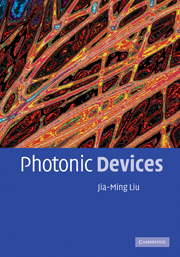Book contents
- Frontmatter
- Contents
- List of figures
- List of tables
- Preface
- Acknowledgments
- Partial list of symbols
- List of abbreviations
- Part I Background
- Part II Waveguides and couplers
- Part III Nonlinear photonics
- Part IV Lasers
- Part V Semiconductor optoelectronics
- Appendix A Symbols and notations
- Appendix B Table of prerequisites
- Appendix C SI metric system
- Appendix D Fundamental physical constants
- Appendix E Fourier-transform relations
- Index
Appendix A - Symbols and notations
Published online by Cambridge University Press: 18 January 2010
- Frontmatter
- Contents
- List of figures
- List of tables
- Preface
- Acknowledgments
- Partial list of symbols
- List of abbreviations
- Part I Background
- Part II Waveguides and couplers
- Part III Nonlinear photonics
- Part IV Lasers
- Part V Semiconductor optoelectronics
- Appendix A Symbols and notations
- Appendix B Table of prerequisites
- Appendix C SI metric system
- Appendix D Fundamental physical constants
- Appendix E Fourier-transform relations
- Index
Summary
Fields
Field vectors and their scalar magnitudes are represented using a consistent system of symbols and fonts. All vectors are represented in bold-face fonts with the exceptions of unit vectors; whereas all scalar quantities are represents in nonbold fonts. This system is illustrated in the following using the electric field as an example.
Real fields
All real fields are defined in the real space and time domain only. All real field vectors are represented in a slanted bold capital Roman font, such as
E(r, t), (A.1)
for the real electric field vector. Other real field vectors are H(r, t), D(r, t), B(r, t), P(r, t), M(r, t), J(r, t), and S(r, t). Except for current density, all real fields are always represented in vector form without separate symbols defined for their scalar magnitudes. The scalar magnitude of J is represented as J.
Complex fields
All complex field vectors are represented in a nonslanted bold capital Roman font. All complex field vectors in the real space and time domain are defined in relation to their respective real field vectors, such as E(r, t) defined in (1.39) for the complex electric field vector:
E(r, t) = E(r, t) + E*(r, t) = E(r, t) + complex conjugate. (A.2)
Other complex field vectors defined in a similar manner are H(r, t), D(r, t), B(r, t), P(r, t), and M(r, t). No complex vector is used for current density.
- Type
- Chapter
- Information
- Photonic Devices , pp. 1018 - 1024Publisher: Cambridge University PressPrint publication year: 2005

